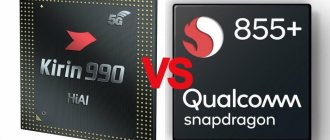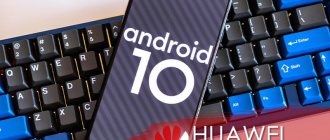A few days ago, Huawei introduced two smartphone models – Honor Play 3 and Honor 20s, and today I would like to talk about the first model in my review.
If we pick up a smartphone, the first thing that catches our eye is the hole in the screen for the front camera. According to the manufacturer, Honor Play 3 is the cheapest smartphone on the market with this design.
It’s not surprising that you can now buy a smartphone at an interesting price of $199.99 with a small discount using the link below.
17%
HUAWEI Honor Play 3: 6.39-inch screen, Hisilicon Kirin 710F, 48.0-MP triple camara, 4000 mAh battery Price: $199.99Show More
Price: $199.99 Show Less
Buy
For this amount you will get a modern frameless smartphone with a large 6.39-inch screen, an updated Hisilicon Kirin 710F processor, 4 and 64 GB versions of memory. Another important feature is a triple camera with a main 48-megapixel sensor.
Very worthy characteristics. So let's get down to the main features of the smartphone and we'll start with the appearance.
Huawei Honor Play 3: Specifications
| Huawei Honor Play 3: | Characteristics |
| Display: | 6.39 inches IPS with 1560 x 720 pixels resolution |
| CPU: | Hisilicon Kirin 710F Octa Core 2.2GHz |
| GPU: | ARM Mali-G51 MP4 GPU |
| RAM: | 4GB |
| Inner memory: | 64 GB |
| Memory card: | up to 512 GB |
| Cameras: | 48.0MP + 8.0MP + 2.0MP main and 32MP front camera |
| Wireless connections: | Wi-Fi 802.11 A/B/G/N/AC, dual-band, 3G, 4G, Bluetooth 5.0, NFC and GPS |
| Battery: | 4000mAh (5V/2A) |
| OS: | Android 9.0 |
| Ports: | micro USB and 3.5 mm audio jack |
| Weight: | 176 grams |
| Dimensions: | 159.8 x 76.1 x 8.1 mm |
| Price: | $ 199 |
Balance of power
Before the advent of the 700 series, Huawei had two lines of chipsets of its own production:
- HiSilicon Kirin 9xx - the most productive solutions for flagship smartphones;
- HiSilicon Kirin 6xx - processors for a wide range of gadgets, from budget to powerful devices in the mid-price category.
With the positioning of Huawei flagships, everything is now clear: the top device must have the senior processor of the Kirin 9xx line. But until recently there was confusion with other devices of the company. Some phones with characteristics close to the top segment received last year's 900 series chipsets. And smartphones a little cheaper could be equipped with representatives of the 600th. The appearance of Kirin 7xx helped to more clearly distinguish between flagships and mid-range models.
Huawei Honor Play 3: Design and screen
The appearance of the device, for a budget smartphone in its segment, looks nice and at the same time modern.
Huawei Honor Play 3 has 2.5D glass on the back panel with an iridescent pattern texture. The manufacturer called this texture “Starlight Rhythm” or “Star Rhythm”. Indeed, the back panel looks stylish and unique in the hands of the user.
Also on the back panel, in the upper left corner, a camera with three sensors was installed. Just below there is a photo flash and at the bottom the company logo.
As you may have noticed, there is no fingerprint scanner on the back panel, since the manufacturer decided not to install it in this model at all. But you can protect your smartphone thanks to the presence of facial recognition through the front camera.
On the front there is a frameless screen with a size of 6.39 inches and there is a round cutout in the screen for the front camera, like flagship models such as Samsung.
At first glance, the screen quality may not seem like a strong point, since the Honor Play 3 has a screen with HD+ resolution or 1560 x 720 pixels. The pixel density per inch is 269 PPI. But in real life, this resolution is quite enough and it is difficult to determine this Full HD or HD resolution with the naked eye.
The bezels around the screen are small, but slightly larger at the bottom than at the edges.
Brightness and color rendition are at a decent level, even on a bright sunny day the screen is readable.
The earpiece is located on the top.
A micro USB port for charging, a 3.5 mm audio jack, a microphone and the main speaker were installed on the bottom edge. Yes, yes, there is a microUSB port, it’s quite primitive, but I would really like to forget about its existence once and for all.
On the right side of the smartphone there is a power button and a volume rocker.
Accordingly, on the opposite side there is a slot for two SIM cards and a memory card at the same time.
The dimensions of Huawei Honor Play 3 are 159.8 x 76.1 x 8.1 mm and weight 176 grams. The smartphone fits well in the hand, the edges of the device are rounded and easy to use.
Conclusion
Of course, the new Kirin 710 is not capable of competing with flagships, but this is not necessary. The chipset does not break records in benchmarks, but it performs well in entertainment, allowing you to run resource-intensive games at a comfortable fps level. I was pleasantly surprised by the high energy efficiency - in this parameter, the Kirin 710 was even ahead of the 10-nanometer Kirin 970. This is exactly what a modern platform for a mid-price smartphone should be like.
How we tested - an addition for the most meticulous readers
Benchmarks. With them, everything is as simple as possible: we ran synthetic tests, having previously closed all other applications, and entered the final result into the table.
Games. Testing was carried out in the GameBench profiler, for which each game was launched for 15 minutes. The received data was taken directly by the application and was not recalculated.
Autonomy. The PCMark Battery Life benchmark ran on gadgets charged to 100% and automatically stopped working at 20% battery charge. The video playback test used the same video with Full HD resolution, compressed using the H.264 standard. The smartphones were switched to airplane mode, and the screen brightness was set to medium. Testing was carried out with 100% battery charge until the phones automatically turned off. The clip was played in the MX Player application.
Normalization of results. Test devices differ in screen size and battery capacity. To prevent this difference from distorting the results, we normalized the battery life obtained in the tests. The area of the smallest display (Huawei P20) and the capacity of the smallest battery (Huawei P20 Lite) were taken as one. For other smartphones, depending on the difference in the parameter, coefficients were calculated. Gadgets with large screens received coefficients of more than one, since they spend more energy on backlighting. Devices with the most capacious batteries were assigned a reduction factor. We multiplied the results of autonomy tests by both coefficients to obtain normalized values.
Huawei Honor Play 3: Performance and operating system
The manufacturer Huawei installed an updated processor called Hisilicon Kirin 710F on the new model, which has shown in practice good efficiency and low power consumption.
The maximum frequency of the Kirin 710F chipset is 2.2 GHz, and it is also supported by the ARM Mali-G51 MP4 graphics processor.
In terms of memory, Honor Play 3 offers 4 GB of RAM and 64/128 GB of internal memory. You can also use the memory card slot.
In the AnTuTu test, our hero scored 170,000 points and for his class this is a good indicator.
In game tests, using PUBG Molibe as an example, the smartphone played at medium graphics settings without any delays or stutters. The same applies to overheating, it is practically absent.
The device runs Android 9.0 with EMUI 9.1.1 user interface.
Stable operation and a large number of pre-installed applications are the usual typical solution for this system. Of course, I don't want to say that the pre-installed applications are superfluous, they will be useful for everyday use.
Qualcomm, Kirin, Exynos: battle of the mid-range segment
Introduction
In 2022, processors (or as they correctly say - System on Chip) from Qualcomm remain one of the most relevant in mid-segment smartphones. Their Snapdragon 600 series lineup has won the hearts and minds of many mobile lovers. But due to cheaper costs and other reasons (for example, the US-China trade war), some manufacturers began to develop chips in this segment themselves. Among the alternatives that vendors use in their devices are Kirin chips from Huawei and Exynos from Samsung. It would also be worth mentioning chips from Mediatek, which have good competitiveness in the mid-price segment. But this article is not about the latter (perhaps a comparison of Mediatek chips with competitors will appear later). But let's look at chips from Qualcomm, Samsung and Huawei in more detail.
Chips for review
Snapdragon 632 is the base model of 2022 on the border of the mid-range and budget segment from Qualcomm. Direct descendant of Snapdragon 625/626 with an updated processor. It has 8 Cryo 250 processor cores (4 Cryo 250 Gold and 4 Cryo 250 Silver) with frequencies up to 1.8 GHz each. The graphics subsystem remained from the previous generation (Snapdragon 625) - Adreno 506, although its performance increased by 10% compared to the 625 chip. Technological process – 14 nm.
Snapdragon 636 is slightly higher than the 632 chip, although it does not reach the full mid-range segment, at least in the Snapdragon line. Judging by the information from the Aida64 utility, this chip has 8 cores of the Cryo 260 architecture, 4 of which operate at a frequency of 1.6 GHz (Cryo Silver), and the rest at 1.8 GHz (Cryo Gold). The graphics part is Adreno 509 with an operating frequency of up to 720 MHz. In fact, this chip acts as a junior version of the Snapdragon 660, having lower frequencies of the processor and graphics subsystems, which negatively affected performance, but had a positive effect on cooling and power consumption. Technological process – 14 nm.
Snapdragon 660 is the most current mid-segment model from Qualcomm in 2018-2019. The processor cores are similar to the Snapdragon 636, but the frequencies are raised to 2.2 GHz (Cryo Gold) and 1.8 GHz (Cryo Silver), respectively. The graphics core is Adreno 512, which is an overclocked version of Adreno 509 from the Snapdragon 636 overclocked to 850 MHz. The technological process is 14 nm.
Snapdragon 665 is an ideological continuation of the Snapdragon 636 rather than the 660. Although it has a higher serial number than the Snapdragon 660, the processor cores have been slightly slowed down. The frequency of 4 Cryo 260 Gold cores was reduced from 2.2 to 2.0 GHz, while the remaining 4 Cryo 260 Silver cores remained at the same level - 1.8 GHz. Graphics chip - Adreno 610. Due to the reduced technical process (11 nm) and slightly reduced frequency of processor cores, the chip has every chance of replacing the aging Snapdragon 636, featuring increased energy efficiency compared to its more expensive counterparts.
Kirin 710 is a mid-segment chip introduced in mid-2018 by Huawei. It replaced the popular Kirin 65* series, which was used by Huawei and Honor throughout 2016-18. The new product was able to raise processor and graphics performance to the level of current solutions from other chipmakers in 2022. In theory, the name hints at a confrontation with the Snapdragon 710; in practice, it is a full-fledged competitor to the Snapdragon 660, albeit with some reservations. Processor part – 4 high-performance Cortex A73 cores at a frequency of up to 2.2 GHz and 4 energy-efficient A53 cores with a frequency of up to 1.7 GHz. The graphics subsystem is ARM Mali-G51MP4, there are more graphics cores and they are newer than the predecessor Kirin 659. The technological process is 12 nm.
Exynos 7904 is a chip on the border of the mid-range and budget segment from Samsung. It was included in the sample because devices based on it are actually competitors to devices with the above-mentioned chips. In practice, it is somewhat inferior to solutions from Qualcomm and Huawei in its price segment (although overall it outperforms the weakest Snapdragon 632). It has 8 processor cores, 2 of which are Cortex A73 (frequency up to 1.8 GHz) and 6 Cortex A53 (up to 1.6 GHz). Graphics subsystem Mali‑G71 MP2. Technological process – 14 nm.
Detailed testing
Let's compare these chips. We will compare based on two parameters – processor and graphics. After all, comparing other parameters (memory speed, support for standards and protocols) would take too much time, and they have virtually no actual impact on performance.
During testing, results for each processor were collected from at least several devices. Snapdragon 632 is represented by only one device, because in practice, devices with this chip have plus or minus the same performance, and the chip itself is included in the sample rather to clearly demonstrate its lag than competition with other test subjects. The Snapdragon 665 is such a new chip that as of August 2022, only one device on the list is running it, the rest (for example, Redmi Note have either just been released or are not widespread.
Let's start with an overall picture of each chip's performance. To do this, let's look at the overall result in the comprehensive Antutu Benchmark test:
Let's start with Qualcomm chips. Snapdragon 632 turned out to be the weakest, followed by the 636 chip, then Snapdragon 660 and 665 compete almost equally. Quite an expected picture.
The Kirin 710 is a competitor to the Snapdragon 660. Its actual results are the closest to the Qualcomm chip, although on average it falls a little short. One thing is for sure - the Kirin 710 confidently outperforms the Snapdragon 632 and 636.
Exynos 7904 is one of the outsiders in this test. And although Samsung has simplified the chip, putting only 2 instead of 4 productive cores, its graphics are still more interesting than the Snapdragon 632, which clearly has problems with this. Therefore, the overall test results for them are comparable, because each has its own advantage over its opponent.
Now let's look at processor performance. Let's start again with the Antutu Benchmark test:
Snapdragon 632, as expected, turned out to be the weakest in the Qualcomm line, although the lag behind Snapdragon 636 is insignificant - less than 5%. I think this is an excellent result for this budget chip, because devices on it are noticeably cheaper than on its 636 brother.
The Snapdragon 636 lags behind the 660 by about 15%, exactly as much as the frequencies of its cores are lower compared to the 660 chip. Only one device on the Snapdragon 660 practically did not break away from the 636 chips - this is the Asus Zenfone Max M2. Apparently, the manufacturer's goal was to increase autonomy rather than maximize performance, but this is the exception rather than the rule for the chip.
Snapdragon 665 competes almost equally with the 660. All the more interesting - either the 660 is prone to overheating and throttling (which, based on the results of comparison with the “colder” Snapdragon 636), or its cores are not quite the same as those on the SD 660. Further tests will show where the truth is.
Kirin 710 – interesting results. Only one of the representatives of this chip, the Honor 8x smartphone, was able to compete on an equal footing with the Snapdragon 660; other devices lagged behind by 10-15%. Honor 8x was one of the first devices on this chipset, and testing was carried out on an earlier version of Antutu Benchmark. Perhaps Huawei at the initial stage managed to “deceive” Antutu by raising the processor frequencies during tests, or Antutu changed the scoring algorithm in new versions of the program, but the result is obvious. In any case, the Kirin 710 scores between the Snapdragon 636 and 660, which is not bad.
Exynos 7904 turned out to be the weakest in the processor test. Its results are on average 15% worse than those of the budget Snapdragon 632. Still, two A73 cores are not enough to fully compete with the above chips. On the other hand, is this so critical in everyday use and games?
To consolidate the result, let's turn to the Geekbench 4 processor test. Its results will be measured performance in single-threaded and multi-threaded modes:
Let's start with the multi-threaded test; its results are closest in meaning to the processor test in Antutu.
Snapdragon 632, as before, turned out to be an outsider among chips from Qualcomm; its gap from the 636 increased from 5 to 10%. A little more noticeable, but not critical. This is still good performance, even compared to older chips.
Snapdragon 636 and 660 – the gap between the first and the second remained at 15%. Which, again, confirms the theory that the 660 copes well with overheating and throttling, at least in these tests.
Snapdragon 665 – the lag from the 660 is at the level of 4-5%, which this time reflects reality, namely, a slowdown in the frequencies of older cores by 10%. A completely natural result, much closer to the chip specifications than the result in Antutu.
Kirin 710 is a decent result, the lag behind the leader Snapdragon 660 is within 4-6%, which is approximately equal to the results of Snapdragon 665.
Exynos 7904 remained the weakest chip in the test. The gap from Snapdragon 632 remained at 14%.
Now let's turn to the single-threaded processor test of the same Geekbench 4.
The performance of the Cryo 250 Gold cores was lower than the Cortex A73 at the same frequency. This allowed, albeit slightly, the Exynos 7904 to get ahead of the Snapdragon 632 (the second is about 6% behind). The Samsung chip was on par with the Snapdragon 636 in the single-threaded test, but falls short of the Snapdragon 665 and Kirin 710.
Snapdragon 660 turned out to be the leader in the single-threaded test. But the gap between the equal Kirin 701 and Snapdragon 665 is not great (about 5-7%).
As a result for the single-threaded test, we can say that the spread of results is not particularly large, because the worst is only 23% slower than the best. For comparison, the most budget Snapdragon 632 in the single-threaded test is 40% ahead of the previous generation (Snapdragon 630) - a significant leap! And all thanks to the new architecture of processor cores, which was introduced in the current generation not only by Qualcomm, but also by Samsung and Huawei.
Let's move on to the graphics subsystem. To do this, let's turn again to the Antutu Benchmark test:
After previous tests, the graphics subsystem test began to sparkle with new colors.
The first thing that catches your eye is the suspiciously low results for the Snapdragon 632. But this is surprising only at first glance. After all, we know that this solution uses the obsolete Adreno 506, introduced back in 2016 along with the Snapdragon 625 and gaining popularity not only in these chips, but also in the Snapdragon 626 and 450. And even increasing graphics performance by 10% (according to compared to Snapdragon 625) did not help here. The gap from its closest competitor, Snapdragon 636, is one and a half times. And the gap from the leader of this test, Snapdragon 660, is more than 2 times.
Snapdragon 636 was second from the bottom with its results. But this does not prevent it from being a good chip compared to its competitors, because the gap from the leaders is not as great as the previous one. Exynos 7904 has approximately the same results, which, after failures in the processor part, gives it additional bonuses in the eyes of the consumer.
The Kirin 710 results also turned out to be quite interesting. Honor 8x with this chip on board shows results at the level of Snapdragon 636 and Exynos 7904, newer devices are closer to Snapdragon 665 and 660. Apparently, the first devices (or firmware) did not have the necessary optimization of graphics drivers, and one should not forget about the technology GPU Turbo, which Huawei continues to develop in its chips.
The results of Snapdragon 660 and 665 are approximately equal, although the latter is 3-5% faster. On the other hand, we must not forget that the Xiaomi Mi A3 on Snapdragon 665 has an HD+ display resolution, which is lower than the FULL HD+ of its competitors on the Snapdragon 660.
Now let's compare the results of graphics tests in Antutu with the results of the 3D Mark program. We will compare using the Graphics parameter (graphical part), and not Total (general results), because in the second case, the readings are influenced, albeit slightly, by the processor part test. Let's look at the graph:
And the results are again a little surprising, especially after the test in Antutu.
Let's start with something simple - Snapdragon 632 is the weakest chip. And although its gap from its closest competitor (Exynos 7904) has decreased to 19%, this is still a lot. Especially considering that the loss to its closest relative, Snapdragon 636, has doubled.
Snapdragon 636 showed a good result, now it is more than one and a half times ahead of Exynos 7904, miracles and that’s all. The gap from the leader, Snapdragon 660, remained at approximately 40%, as in the previous test.
The differences in results for the Kirin 710 remain large. Only now this cannot be explained by the release date of the smartphone. But one thing can be said for sure - the Mali-G51MP4 from its composition is approximately equal to the performance of the Adreno 509 from the Snapdragon 636. This does not give a lead as in the Antutu test, but having performance at the level of the average from Qualcomm is not bad. Don't forget about GPU Turbo - optimizing graphics performance in games can work in Kirin's favor.
The Snapdragon 665 began to lag behind the 660 chip, which is surprising. I had to compare them in the results of other tests from the 3D Mark program (for example, Slight Shot, Ice Storm Unlimited), but the result is the same everywhere. Both in the graphics and in the processor part (Physics test), the Snapdragon 665 is inferior to the 660 chip. I have to admit that the Snapdragon 665 is about 15-20% slower than the 660 in the graphics subsystem. We can only hope that, perhaps, in future updates Qualcomm will update the drivers and better optimize the chip in terms of the graphics part.
Exynos 7904 – rather weak results, although higher than those of the outsider Snapdragon 632. Still, two Mali G71 cores were not enough, and if Samsung had followed the example of Huawei with their 4 Mali G51 graphics cores, there would have been a completely different level of performance. In total, the gap from its closest competitors, Snapdragon 636 and Kirin 710, is more than one and a half times.
Summarizing the results of graphics tests, we can say the following. Antutu and 3D Mark tests showed significantly different results for several models at once - Kirin 710 and Exynos 7904. Unfortunately, the author has no explanation for this phenomenon. But to draw conclusions about these chips, we will start from the worst results for the chips (and the author has more confidence in the 3D Mark program).
The worst results, regardless of the test, came from the Snapdragon 632. I do not advise gamers to buy it. The Exynos result is not far from the previous chip, the same insufficient gaming performance, especially since devices on this chip (unlike many on the Snapdragon 632) do not have HD+, but Full HD+ screens, which additionally loads them. The first worthy chip in our sample can be called the Kirin 710 - yes, not at the level of the Snapdragon 660, but at least as high as the 636th or even higher. Well, Snapdragon 665, 660 and 636 can traditionally be recommended for game lovers who do not want to overpay. On the other hand, active gamers can buy new or slightly used. smartphone on Snapdragon 820, 835 or even 840, but there is a completely different gaming performance! But that's a completely different story.
conclusions
Mid-segment chips in 2022 showed growth in both processor and graphics performance. The updated architecture of processor cores helped make a significant leap forward, especially in single-threaded tests, compared to previous generations. The graphics part has also improved, only the Snapdragon 632 model was disappointing, but this chip is closer to the budget segment. I really liked the results of the Kirin 710 - taking into account the current prices of devices on it, this is one of the most profitable purchases in the summer-autumn 2022. Samsung with its Exynos 7904 is a little behind, but not everyone chooses devices only for maximum performance? Qualcomm traditionally holds the bar of leadership, presenting the widest selection of chips in the mid-range segment, and the cost of devices with chips of different performance may overlap, it all depends on the manufacturer.
Huawei Honor Play 3: Camera
Another main feature of Huawei Honor Play 3 is the camera, namely three sensors on the rear panel. The first is 48-megapixel with f/1.8 aperture and Sony IMX582 Exmor RS sensor. A second 8-megapixel sensor with f/2.4 aperture for ultra-wide shots with an angle of 120º. And the last third sensor is 2 megapixels with an f/2.4 aperture for macro photography.
On the front panel, a 32-megapixel front camera with f/2.0 aperture was installed.
Below you can see examples of photographs and evaluate the quality of the images. For me, during the daytime the photos come out with good detail and correct colors. But night photos are a little worse. I also liked the ultra wide lens, which can capture more space in one photo.
Today, the camera for a modern budget smartphone is the main indicator and Huawei Honor Play 3 has a pretty good camera for its price.
Huawei Honor Play 3: Battery
A large 4000 mAh battery was installed in the body of the Huawei Honor Play 3 device, which can work on a single charge for about 2 days with active use.
Thanks to the updated Kirin 710F processor, which has low power consumption, and low screen resolution, the Honor Play 3 smartphone can be used for a very long time.
Charging time will be about 3.5 hours via microUSB port and 10 W power adapter.











